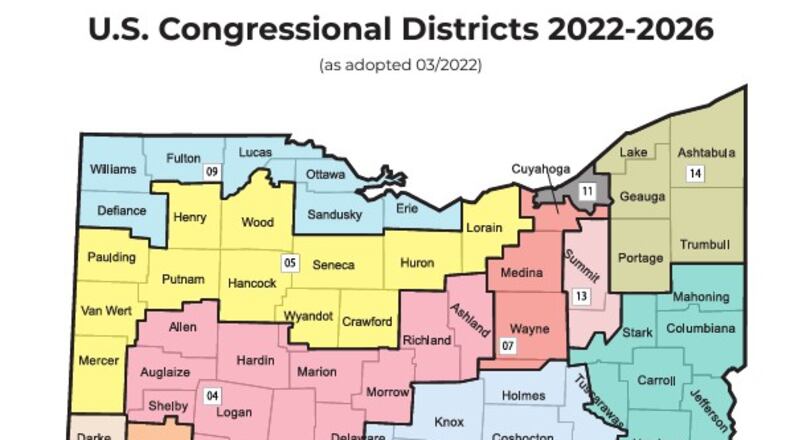INSIDE OHIO POLITICS: Go here for more from our special reporting project explaining the inner-workings of Ohio statehouse politics.
Ohio’s congressional redistricting process is almost entirely spelled out in its constitution after Ohio voters approved a bipartisan reform measure in 2018. Under those rules, the congressional map created in 2021 after the most recent U.S. Census is only good through 2026 because the maps were approved without requisite support from Democrats.
This sets Ohio apart from other states, whose maps are theoretically good through the 2030 election cycle and are due to be updated after the 2030 Census, barring intervention from those states’ leaders.
And with Republicans in control of all key state offices and holding supermajorities in both chambers of the Ohio General Assembly, some suggest this gives the GOP an opportunity to gerrymander in the party’s favor and help sway the balance of power in Washington D.C.
How Ohio’s redistricting process works
The Ohio Constitution allocates map drawing responsibilities, establishes required deadlines, and provides specific parameters for mapmakers to follow in creating an enforceable map. Here’s how the process works:
Stage 1: Ohio General Assembly
The Ohio General Assembly has until Sept. 30 to come up with and approve new congressional maps.
In order to take effect, the legislature’s proposal would need to be approved by a three-fifths vote in both the Ohio House and Senate, with the added stipulation that the map would need majority support from the Republicans and Democrats of each chamber.
Failure to meet that threshold by the end of September would kick the process to its second stage.
Ohio’s constitution requires the legislature’s map proposals to come in the form of a traditional bill, which makes any plan approved in this first stage subject to a governor’s veto or public referendum.
Stage 2: Ohio Redistricting Commission
If the legislature fails, then the responsibility falls on the Ohio Redistricting Commission — a seven-member board made up of Ohio’s governor; auditor; secretary of state; and two other designees per party, picked by Republican and Democratic legislative leaders.
Ohio’s governor, auditor and secretary of state are all Republicans.
The redistricting commission would have until Oct. 31 to create and approve a map. Like the legislature in the first stage, it is required to have a bipartisan vote to adopt its map. A redistricting commission map can be approved by affirmative votes from four members of the committee, including support from at least two Democrats and two Republicans.
Failure to meet that threshold before the Oct. 31 deadline sends the process to its third stage.
Stage 3: Back to the legislature
The Ohio General Assembly would get a second bite of the apple if the redistricting commission were to fail, this time with the goal of producing a map that could get three-fifths support from both chambers, including support from at least one-third of the members of each chamber’s Democratic and Republican caucuses, before Nov. 30.
In this stage, however, the Ohio Constitution allows for a temporary map to be adopted with just a simple majority vote.
A map passed in this stage, like the first stage, can be vetoed by the governor or become the subject of a voter referendum.
Isn’t gerrymandering prohibited?
The Ohio Constitution doesn’t really address gerrymandering in the first two steps outlined above, relying instead on the effort to get a 10-year map with bipartisan support.
But if lawmakers create a temporary map passed on a partisan basis, the constitution does list certain restrictions:
- The legislature’s map cannot “unduly” favor or disfavor a political party;
- The plan’s districts cannot unduly split local governmental units;
- The legislature must at least “attempt” to draw compact districts;
- The plan goes into effect for two election cycles, which in this case would be for the 2026 and 2028 elections.
How we got here
In 2021, Ohio’s political leaders took on the task of redrawing congressional districts for the first time since Ohio voters overwhelmingly (with nearly three-quarters of voters in support) voted in 2018 to amend the Ohio Constitution to create the current process.
It didn’t work. Republican officeholders and legislative leaders pushed through maps with little support from Ohio Democratic leaders, going through the three-stage process outlined above and ending up with a temporary map.
The League of Women Voters of Ohio and others sued, and the Ohio Supreme Court deemed the map unconstitutionally gerrymandered in favor of Republicans, with Republican Chief Justice Maureen O’Connor siding with the court’s three Democrats and casting the deciding vote.
Credit: Jim Gaines
Credit: Jim Gaines
But a federal court ruled the maps had to be used in order to carry out the 2022 election.
After O’Connor left office and the balance of power on the state’s high court changed in 2022, the League dropped their lawsuit and instead backed an effort to amend the Ohio Constitution again to remove politicians from the redistricting process. But Ohio voters rejected the proposed reforms in the 2024 election.
So that leaves us with the current map that is only good for the 2022 and 2024 election cycles. This year it falls to Ohio elected officeholders and legislative leaders to again draw a map using the steps outlined above.
But now, it’s happening amid a national fervor over congressional maps.
Partisan politics
The two election cycles that used Ohio’s expiring maps resulted in the election of 10 Republicans and five Democrats to represent the state in the U.S. House — with only a handful of competitive districts.
Ohio House Minority Leader Dani Isaacsohn, D-Cincinnati, told this news outlet that he’s hoping for — and believes the law calls for — a new map to give Republicans less of an advantage.
“Right now we have maps that are out of whack with where Ohioans are,” Isaacsohn said. “We live in a state that leans Republican, so we should have congressional districts that lean Republican. That’s probably, for 15 seats, an eight-to-seven (split) with some tossups.”
But Ohio Republicans are again in the driver’s seat. Ohio House Speaker Matt Huffman, R-Lima, previously suggested it may be possible to have a bipartisan bill in September after informal negotiations this month.
Credit: AP
Credit: AP
But GOP leaders could again push through a map without Democratic support that would stand for the next two congressional elections, in 2026 and 2028. And this time the Ohio Supreme Court, which could be asked to weigh whether a temporary map is gerrymandered, has a six-to-one Republican advantage.
U.S. Sen. Bernie Moreno, a Republican, thinks the state’s new maps should give Republicans a 12-to-3 advantage, according to The Ohio Capital Journal.
But, despite external pressures, Isaacsohn maintained a guarded optimism that the Republicans won’t use the opportunity to stretch their advantage even further.
“The Speaker has said publicly that he is not amenable or susceptible to pressure from outside forces, including those in D.C., and I certainly hope that’s the case,” he said.
Looking ahead
Jen Miller, executive director of the League of Women Voters of Ohio, told this news outlet she doesn’t want to predict what would happen in the forthcoming redistricting process.
But, Miller said she doesn’t expect the national conversation around redistricting to make advocating for fair maps more difficult. Which is to say: “I think redistricting is always hard when politicians are in charge.”
“The national conversation proves that politicians should not be part of the redistricting (and) that both parties, when given the power, will rig maps for their candidates,” she said. “We stand firmly against gerrymandering, no matter who is doing it.”
Credit: Credit to Glenna Jennings
Credit: Credit to Glenna Jennings
While there are plenty of factors that go into making a fair district map, Miller said she places value on “proportional fairness” — whether a map’s competitive advantages are in line with the electorate’s political preferences. Miller explained the goal is a map where “the percent of votes cast for each party generally mirrors the percent of seats each party would get.”
“The foundation (of a fair map) should be districts that don’t split communities of interest and bring together communities that are very alike. Right now we have these sprawling, weird-shaped districts that smoosh together populations of people that have very different needs from infrastructure and the economy, healthcare and more,” Miller said. “So the foundation really is keeping communities together, but a good measure is proportional fairness.”
For more stories like this, sign up for our Ohio Politics newsletter. It’s free, curated, and delivered straight to your inbox every Thursday evening.
Avery Kreemer can be reached at 614-981-1422, on X, via email, or you can drop him a comment/tip with the survey below.
About the Author




